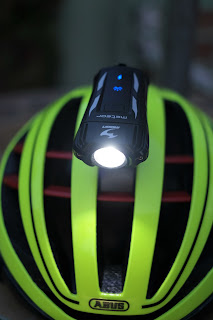Wet, gritty stuff not only consumes chains and other drivetrain components but brake seals and springs too, it seems. Having exited a junction, my relative serenity was interrupted by a strange binding noise. I initially believed it was this BTwin Triban shoe slipping off the Wellgo’s surface, causing my heel to nudge the mudguard out of alignment.
The chainstay bridge bolt needed nipping tight but there was an unusual amount of slop in the rear brake. I predominantly use the front but nonetheless, the rear needs to be bang-on. Given I was by the roadside, seven miles from home, on a very dark and rainy night, I centered the Avid Shorty 4 and made a mental note to strip and inspect once I’d returned.
Univega on my long-serving aluminium alloy work stand, I stripped the Avid and discovered the spring had sheared clean in two. Claimed by fatigue but slightly odd, given it didn’t lead a particularly hard life. Presented and opportunity to re-grease the bosses and mounting hardware.
A nice stiff grease-Park PPL1 https://www.sevendaycyclist.com/park-tools-polylube-1000 being the obvious choice, since it was already loaded into my gun. The Genetic CX cantilevers, were an obvious substitute.https://www.sevendaycyclist.com/genetic-cx-cantilever-brakes However, small frames, wide arm cantilevers and size 43/44 feet are a recipe for heel clearance hassles.
Therefore, I opted for these Shimano CX50. A relatively low- profile model designed to work with Super SLR levers, hence no compatibility (cable pull) hassles with road brifters. Set up is relatively straightforward too and I was able to utilise the existing straddle wire. Rather than Shimano’s Y pattern.
I’ve also been contemplating a new ring-at the right price. 94BCD is starting to become the preserve of retro pricing these days and choice is similarly, restrictive. Therefore, replacements can be very cheap, or very steep. Research suggests a 36 tooth is as close as I’ll get.
Though adequate, I’d welcome a slightly lower, closer spread of gears, while still enjoying a 1x10’s simplicity. Much of this has been prompted by persistently high winds. Conditions that have defined the past few months, here in the UK.
I have also been pleasantly surprised by the stoicism of the Juice Lubes Frame Juice. It does attract some grimy patina but this gets locked into the top layer, meaning you simply dismiss this, using a soft, lint-free cloth.
An invisible, protective barrier remains and has done so for several weeks before replenishment’s been necessary. One minor consideration is that its designed for gloss finishes, so something like Naked Bikes Bike Bling https://www.sevendaycyclist.com/naked-bikes-bike-bling might probe a more cost-effective option if you have a bike or fleet with gloss/satin and matt surfaces.
Now, no sooner had I played musical saddles; this rather fetching Cycles Berthoud Soulor leather saddle arrived at my door. Measuring 278x146mm and tipping the scales at 423g, its actually 40 odd grams lighter than this titanium railed SPA cycles Aire. One that served on my fixed gear winter trainer, for a good few thousand miles.
The Aire is made from Australian cowhide, which tends to be thicker and subsequently, took longer to break in. Even with periodic deployment of Proofide/similar leather “food” it took 500 miles before the Aire was moulding to my derriere.
Putting this into context, a modern Brooks is 250 miles, give, or take. The solour’s rails are a highly polished stainless steel (although there are titanium siblings, if you can stretch to £189) which adds some compliant zing. Unlike electroplating, there’s little risk of them tarnishing, although stainless steels are alloys of different metals. Therefore, a quick buffing and occasional hard-paste waxing never goes amiss.
In common with the Spa cycles Aire, the underside appears to have been treated, offering it greater protection from the elements. A lesser consideration with full length mudguard perhaps but again, another consideration when buying traditional leather saddles.
Thus far, ours feels more like a Brooks Swift. Quite firm but not unforgiving. Even so, bedding in has been a very gradual process, starting with as few 25mile loops, before increasing the mileage by ten miles each time, giving the top side periodic helpings of a water-based hide food, to assist this assimilation to my ass.
Although the evenings are getting steadily lighter and seemingly less wintry, good lighting remains a must. I love the convenience of dynamo systems-at least up front. Though failures are pretty rare these days, I always run these in conjunction with a compact, commuter type light up front and two rear lights. Aside from presence, so long as good charging discipline’s maintained should one fail, there’s another to get home with.
Again, being someone who predominantly tackles unlit roads, 15-20 lumens is my minimum-even for a secondary/contingency unit. Up front, even with the dynamo, I tend to go for a 500lumen light, defaulting to flashing (100-150 lumens). However, a steady 250/400/500 lumen mode is really useful for tackling punctures and similar roadside mechanicals-especially if you can mount it atop a helmet, leaving both hands free to do the fixing.
These Moon Meteor and ETC Sirrah Front/Rear Light have proven particularly good defaults. I’ve also been pleasantly surprised by the Oxford Products Ultratorch R75 rear Light https://www.sevendaycyclist.com/oxford-ultratorch-r75-rear-light . Its bright, with sensible staircasing, although run times are relatively modest and favour commuting/winter training, rather than longer distance/endurance events.











No comments:
Post a Comment